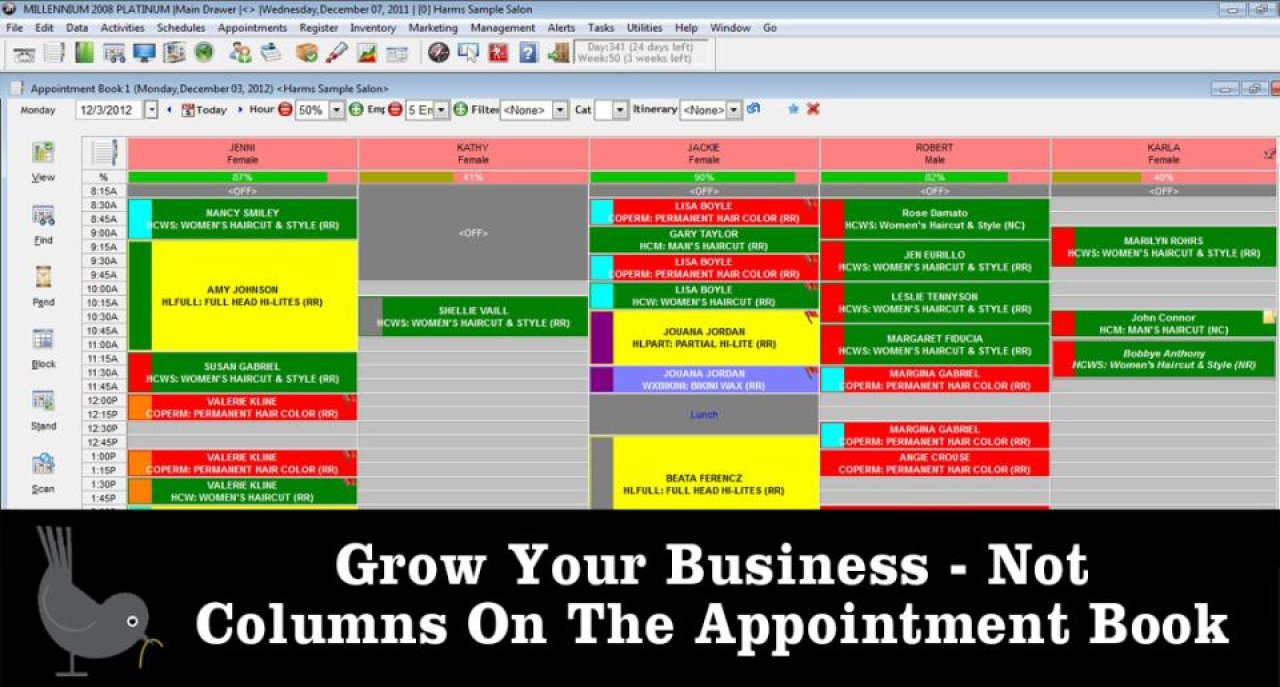Grow Your Business, Not Columns On The Appointment Book

Arrojo had a walkout ... no different than the countless walkouts experienced by salon owners since the birth of the professional salon industry. Ask any gathering of salon owners if they have experienced a walk-out and all but a fortunate few will confirm they have. Like Nick Arrojo, the stories are like rubber-stamped accounts of broken trust, lost investment, plotting, collusion, stealing, lost revenue, bad-mouthing and the arduous task of rebuilding. All are stories of a business that took years to build that were blown up with their once employees, clients and cash flow relocated down the street.
The traditional approach of growing a salon is truly the definition of insanity. What most owners don't realize is that the traditional, and inherently dysfunctional, business model feeds the walk-out scenario in a big way. Simply apply the rule of "what gets measured gets repeated", and the traditional salon business model virtually assures the perfect conditions for a walk-out are in place. Consider the following:
- You tell stylists to "build their book."
- You tell stylists to build their "request rate."
- You tell them to promote "themselves."
- You measure their success based on "their" request rate and how "booked" they are.
- You increase "their" prices based on how full "their" column is.
- You pay them a commission or sliding scale based solely on "their" sales.
Given the preceding points ... how can you possibly build a viable company and brand that isn't susceptible to the ravages of a walkout? Keep working the same business model and you keep proving that the definition of insanity is doing the same thing over and over again and expecting a different result.
Here is my five-step approach to building a business - not just columns on the appointment book:
STEP ONE: Resolve the conflict between "I/me/mine" and "We/us/team."
- All systems, pay included, must acknowledge and reward thinking and behavior that support teamwork.
- Overhaul your company's language and terminology. "We/us" replaces "I/me." "Our" replaces "mine." It's subtle but VITAL to creating a true team-based culture.
STEP TWO: Stop tracking "Request Rate." Request rate is your "walkout factor."
- Do you really want to measure your company's walkout factor?
- Do you really want to track and reward employees based on how much damage they can do should they walkout?
- Do you really get how contradictory request rate is to building a sustainable business?
Replace “request rate” tracking with first-time and existing client retention rates. It doesn't matter who clients return to ... as long as they return to the company.
STEP THREE: Eliminate "Column Vision."
Ask your busiest stylist to look at the salon's appointment book and tell you what he/she sees. 99.9% of the time, the answer will be "I'm booked." All the stylist sees is his/her column. That's the resulting mindset of request tracking, I/me/mine and commission compensation.
- Daily huddles engage team thinking and focus on team priorities.
- Scoreboards that identify team goals and track team progress to goal, replace the constant and repetitive emphasis on driving individual sales.
- Waiting lists for the already too busy service providers shift from ego and gridlock to the team sharing the workload.
- Double and triple booking to drive more business through one column on the appointment book is recognized for what it truly is ... a compromise of the customer service experience.
- The busiest service providers recognize and understand that their future earning potential resides in the hours and talent available on other columns on the appointment book. (This is the foundational component of Team-Based Pay.)
- AND ... it just never made sense for a salon to have some overworked stylists with waiting lists and other stylists waiting for something to do.
STEP FOUR: True teamwork is about driving Overall Company Productivity Rate.
This is a major shift from the time and inefficiency of growing columns on the appointment book. It is the ultimate culture shift from column vision and I/me/mine. Strategies catch phrases are:
- Everyone is responsible for every hour the company has available for sale.
- The skills of the entire company are available to each and every client.
Growing a viable business is about driving your Overall Company Productivity Rate. That's why as an owner, you obsess over white space on the appointment book.
QUESTION: How quickly would that white space fill if it was a team responsibility and owners no longer had to obsess alone?
QUESTION: How much better could you pay service providers if your company consistently enjoyed the efficiency of higher productivity rates?
Want a stupidly-simple to quickly and easily start increasing productivity rates? Check out Strategies' Happiness System. It'll also help drive retail sales and client retention rates, as well.
STEP FIVE: Your Brand IS everything
There is a radical difference between a salon filled with stylists with followings and a salon filled with clients being serviced by a team.
- The “stylists with followings” model is highly vulnerable to walkouts.
- The “clients being serviced by a team," although not immune, is significantly less vulnerable to a walkout.
- If salons trained clients to be loyal to one stylist ... then salons can train clients to enjoy the benefits of being serviced by a team of professionals.
- The stronger your brand and team-service concept - the greater client confidence in utilizing the skills and talents of the entire company.
- You may have an amazing looking salon, but if the clients that patronize your company are loyal to one service provider ... you have failed to create a viable brand that attracts and retains clients. You have simply created a great space for stylists to service "their" clients until they leave.
"Sense of Urgency” for differentiation
Many stylists with client followings see little difference between working in a salon on commission and renting a booth or suite. When you factor in "column vision" thinking, they are, in many ways, functioning as an independent.
Employee-based salons have an opportunity to end the devastation of walkouts and the insanity of hostage management. To do so will require a shift to a team-based business model.
Ready to make this stuff a reality in your salon/spa but don't know where to start? Sign up for a FREE one-hour coaching call with one of our Certified Strategies Coaches. This stuff is what we do, and we'd love to help you get started.
- - - - - - - - -
Please share your thoughts with me about today's Monday Morning Wake-Up. Click below to comment.
Pass this e-mail on to your business colleagues, managers and friends. They will appreciate it.


Comments
No comments found. Start the conversation!
Leave a Comment